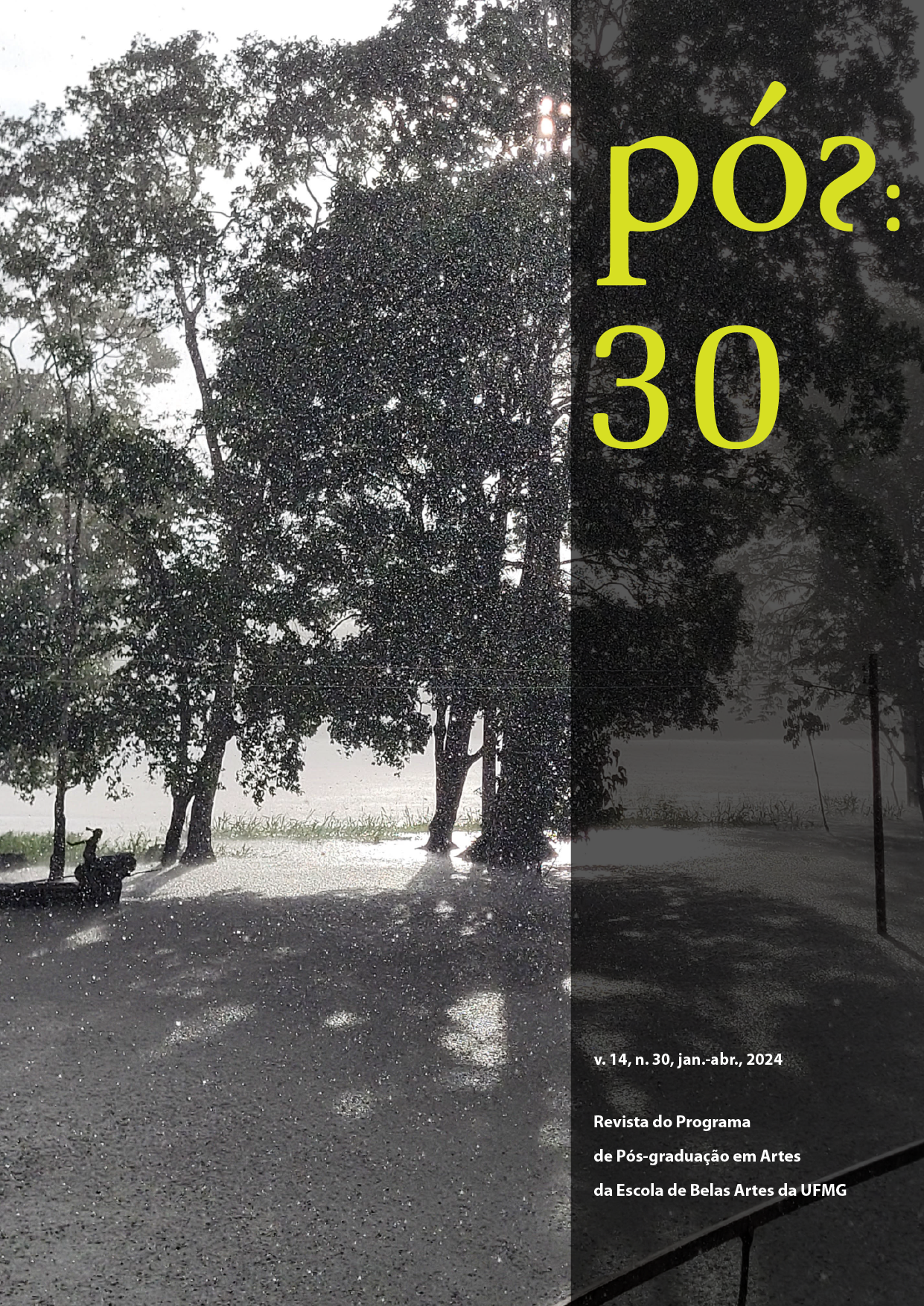About Art, Technique and Time
Ritxòkòs
DOI:
https://doi.org/10.35699/2238-2046.2024.48682Keywords:
Ritxòkòs, Karajá, natureAbstract
The ritxòkòs – ceramic statues from the potters of the Karajá ethnic group are an Inỹfiguration of a “unison nature”, with an inventive capacity, created without any link to the chronological time of the tori. The aim is to argue that ritxòkòs is a technique intertwined by three cosmological levels: sky, earth and water. The methodology used is qualitative, exploratory-observative-descriptive in nature, and based on a review of the critical fortune of ethnographic research by Sandra Campos (2007) and Chang Whan (2010). The concepts of “decolonial”, “time” and technique were revisited in the works of Leda Martins and Nêgo Bispo and others, and the concepts of agency and technique, respectively, in the works of thinkers Alfred Gell (2018) and André Leroi-Gourhan (1984). After the investigation, it was confirmed that aesthetic production is intertwined in everyday relationships, in the extended time of production and in the non-subjectiveness of the potters, and that doll is not the best term to talk about ritxòkòs, since this is a tori name, between others.
References
CAMPOS, Sandra M. C. de la Torre Lacerda. Bonecas Karajá: modelando inovações, transmitindo tradições. 2007. 153 f. Tese (Doutorado em Ciências Sociais e Antropologia) – Pontifícia Universidade Católica de São Paulo, São Paulo, 2007.
CÂNDIDO, Manuelina Maria Duarte; ROCHA, Bárbara Freire Ribeiro. Presença Karajó: biografías e biofilia em uma investigação sobre cultura material. ACENO: Revista de Antropologia do Centro-Oeste, v. 8, n. 16, p. 293-306, 2021.
FARIAS, Joana Silva de. Modelando parentes: sobre as redes de relações da ritxo[k]o entre os Karajá. 2014. 168 f. Dissertação (Mestrado em Antropologia Social) – Programa de Pós-graduação em Antropologia Social, Faculdade de Filosofia, Letras e Ciências Humanas, Universidade de São Paulo, São Paulo, 2014.
FENELÓN COSTA, Maria Heloísa. A arte e o artista na sociedade Karajá. Brasília: Fundação Nacional do Índio, 1968.
FUNARTE. Fundação Nacional de Arte. Instituto Nacional de Artes Plásticas. (Catálogo). Coleção Museus Brasileiros, nº 4. Museu Paraense Emílio Goeldi. Rio de Janeiro: Funarte, 1981.
GELL, Alfred. Arte e agência: uma teoria antropológica. São Paulo: Ubu, 2018.
HOYUELOS, Alfredo. A estética no pensamento e na obra pedagógica de Loris Malaguzzi. São Paulo: Phorte, 2020.
IPHAN. Instituto do Patrimônio Histórico e Artístico Nacional (Brasil). Sistema Eletrônico de Informação – SEI. Processo nº 01450.005542/2010-13: Processo de Registro – Bem Imaterial: Bonecas Karajá como patrimônio cultural brasileiro. Data de registro: 9 de abril de 2010. Brasília, DF, 25 de janeiro de 2012. Disponível em: http://portal.iphan.gov.br/noticias/detalhes/1190/bonecas-karaja-novo-patrimonio-cultural-brasileiro. Acesso em: 10 jul. 2023.
INSTITUTO SOCIOAMBIENTAL. Plataforma virtual com acervo relativo a povos indígenas, populações tradicionais e meio ambiente. 2023. Disponível em: https://acervo.socioambiental.org/index.php/sobre. Acesso em: 10 jul. 2023.
LEROI-GOURHAN, André. Evolução e técnicas: o homem e a matéria. Lisboa: Edições 70, 1984. (v. 1).
MARTINS, Leda Maria. Performances do tempo espiralar: poéticas do corpo-tela. Rio de Janeiro: Cobogó, 2021.
MAUSS, Marcel, Introducción a la Etnografia. 2a ed. Madrid: Ediciones Istmo, 1974.
IPHAN. Instituto do Patrimônio Histórico e Artístico Nacional (Brasil). Parecer nº 41/2011/CGIR/Dpi/Iphan. Processo nº 01450.005542/2010-13, referente ao Registro do Ofício e dos Modos de Fazer as Bonecas Karajá. Brasília, DF, 25 de janeiro de 2014. Disponível em: http://portal.iphan.gov.br/noticias/detalhes/1190/bonecas-karaja-novo-patrimonio-cultural-brasileiro. Acesso em: 19 dez. 2022.
PELBART, Peter Pál. O tempo não reconciliado: imagens de tempo em Deleuze. São Paulo: Perspectiva: FAPESP, 1998.
PELBART, Peter Pál. Vida capital: ensaios de biopolítica. São Paulo: Iluminuras, 2003.
PELBART, Peter Pál. Tempos de Deleuze. Revista Limiar: Filosofia, Invenção e Arte, v. 8, n. 15, p. 107-123, 2021. Disponível em: https://periodicos.unifesp.br/index.php/limiar/article/view/12567. Acesso em: 20 set. 2023.
RIBEIRO, Berta G. Dicionário do artesanato indígena. Belo Horizonte: Itatiaia; São Paulo: Edusp, 1988.
STIEGLER, Bernard. Reflexões [não] contemporâneas. Organização e tradução: Maria Beatriz Medeiros. Chapecó: Argos, 2007.
VIVEIROS DE CASTRO, Eduardo. A inconstância da alma selvagem; e outros ensaios de Antropologia. São Paulo: Ubu, 2017.
WHAN, Chang. Ritxoko: a voz visual das ceramistas Karajá. 2010. 205 f. Tese (Doutorado em Artes Visuais) – Programa de Pós-Graduação em Artes Visuais, Escola de Belas Artes, Universidade Federal do Rio de Janeiro, Rio de Janeiro, 2010.
Downloads
Published
Versions
- 2024-05-13 (2)
- 2024-04-01 (1)
How to Cite
Issue
Section
License
Copyright (c) 2024 Prof. Cássia Macieira

This work is licensed under a Creative Commons Attribution-NonCommercial 4.0 International License.
Authors who publish in this journal agree to the following terms:
- Authors retain copyright and grant the journal the right of first publication, with the work simultaneously licensed under the a Creative Commons Attribution-NonCommercial 4.0 International License that permits sharing of the work with acknowledgement of authorship and initial publication in this journal;
- Authors are permitted to enter into additional contracts separately, for non-exclusive distribution of the version of the work published in this journal (e.g., the Creative Commons Attribution License).
- Authors are permitted and encouraged to publish and distribute their work online (e.g., in institutional repositories or on their home page) at any point before or during the editorial process, as this may generate productive changes as well as increase the impact and citation of the published work.
- It is the responsibility of the authors to obtain written permission to use in their articles materials protected by copyright law. Revista PÓS is not responsible for copyright breaches made by its contributors.











